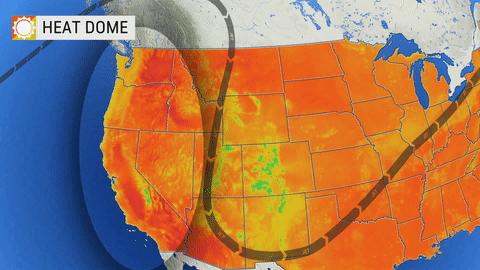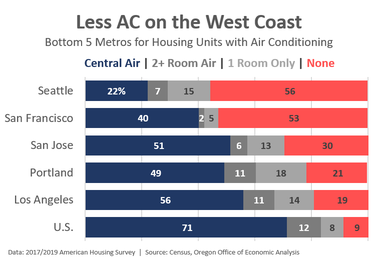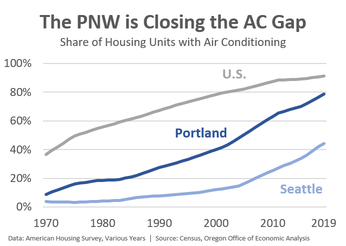By Andy Meeks, July 2, 2021
As we emerge on the other end of the historic Heat Dome of 2021 – when heat records were shattered throughout the Pacific Northwest (116 degrees in Portland, 108 in Seattle), and at least 79 people died of heat-related causes in Oregon – it’s time to take stock of how well prepared we are, especially in our homes, to handle the effects of climate change that will surely continue to wreak havoc and rewrite record books in the coming years. One of the most important ways we can prepare ourselves to handle these heat waves is to have a well-insulated home that also has air conditioning.
I’m not a native Oregonian – I moved from New England in 2008 where summers are hot and humid and where the heat of the day greets you almost as soon as the sun rises – so when I moved here it was interesting to hear people talking about not needing air conditioning in their homes. But after learning and experiencing more about the climate in the Pacific Northwest, it made complete sense. There really was no need. However, what we’ve experienced here in our summer weather in those past 13 years — not to mention smoke from wildfires — it’s become abundantly clear that air conditioning has gone from an extravagance to a necessity. And the data bears this out: the Pacific Northwest’s general reticence for air conditioning has melted away in the past two decades. In 2002, approximately 44 percent of Portland area dwellings had air conditioning. By 2019, that figure rose to 79 percent, and we’re surely past that now.

For more insights into the data around air conditioning usage in the Pacific Northwest and how it compares with the United States, I’d like to share a recent newsletter article from Josh Lehner, reprinted in its entirely below.
Josh Lehner is an economist for the Oregon Office of Economic Analysis and writes excellent summaries for all aspects of Oregon’s economic activity and is always supported by great research and with an accessible narrative. Below is Josh’s recent article about air conditioning in the Pacific Northwest from June 30, 2021 titled “The Fever Is Broken. You can also subscribe to Josh’s free newsletter HERE (highly recommended).
===
By Josh Lehner, Oregon Office of Economic Analysis
“We made it back home just in time for the heat dome. The worst of it is over for the western part of the state while central and eastern Oregon have another day or two it looks like. But even then, the forecast calls for merely hot instead of extreme temperatures. It’s likely the risks have increased in terms of the impact from the current drought, and any fallout from this year’s wildfire season. While I know many of you found our office’s old post on air conditioning, I did want to share two charts this morning based on the new 2019 American Housing Survey data that was released last fall.
First, major metros on the West Coast have the lowest rate of AC usage in the country. If we combine the 2017 and 2019 AHS data (the metros rotate) Portland ranks 4th lowest out of the 35 in the data. One in five Portland households do not have AC, more than double the national share.
Second, a question I have seen pop up a number of times in recent days is why doesn’t the NW have more air conditioning? Shouldn’t AC be increasing noticeably due to climate change? As seen in the chart below, it very much is. In the past 15 years, Portland’s AC usage has basically doubled, going from 43% in 2002 to 79% in 2019. For much of the late 20th Century, Portland’s AC usage trailed the nation by about 40 percentage points. Today it is 13 percent. Seattle has gone from trailing the nation by 60-70% to “just” 47% today as AC usage has tripled in recent decades going from 15% in 2004 to 44% in 2019.
More importantly for the health of our neighbors and ourselves, the actual number of households without AC has fallen outright. Between 2002 and 2019, the number of households in the Portland region without AC declined by more than 250,000. It’s not just that new construction is boosting the AC figures (it does) but that older units are adding AC at the same time. The same overall pattern is seen in the fishing village up north, but starting from a much lower base of AC usage likely in part to being both on the water, and further north.”



